Both of these cameras are called the Kodak 35. At first glance, they don’t look much alike, but in reality they are examples of the same model, one from early in it’s life, and the other from near the end. The Kodak 35 was Kodak’s first US built 35mm camera to use its 135 format film cassette. The earlier Kodak Retina was built in Germany by Nagel, who Kodak owned. The Kodak 35 was designed to compete against the Argus A and C series cameras which were inexpensive Bakelite bodied cameras made in the USA. Despite having the benefit of a better lens and shutter, plus the Kodak name, the Kodak 35 was outsold by both Argus cameras and were eventually discontinued around 1950.
Kodak 35 Original
Film Type: 135 (35mm)
Lens: 50mm f/3.5 Kodak Anastigmat Special uncoated 4-elements
Focus: 3′ 6″ to Infinity
Type: Viewfinder
Shutter: Kodak No. 1 Kodamatic Leaf
Speeds: T, B, 1/10 – 1/200 seconds
Exposure Meter: None
Battery: None
Flash Mount: None
Manual: http://www.cameramanuals.org/kodak_pdf/kodak_35_f3_5.pdf
Kodak 35 Rangefinder
Film Type: 135 (35mm)
Lens: 50mm f/3.5 Kodak Anastar Special coated 4 elements
Focus: 3′ 6″ to Infinity
Type: Coupled Rangefinder
Shutter: Kodak Flash Kodamatic Leaf
Speeds: T, B, 1/10 – 1/200 seconds
Exposure Meter: None
Battery: None
Flash Mount: None
Manual: http://www.cameramanuals.org/kodak_pdf/kodak_35.pdf
History
The Eastman-Kodak company had an undeniable influence on the photographic industry of the late 1800s and early 1900s. They were pioneers in both film and camera design. They released the first reloadable consumer camera in 1888, simply called the “Kodak”. They invented daylight loading roll film and helped to standardize almost all formats of film in the 20th century. They invented 135 format 35mm film which is still sold today and has been the most popular and best selling film ever made. The designs of their cameras ran the gamut from extremely basic box cameras to extremely high end cameras with state of the art features and excellent lenses.
The odd thing however, is that Kodak never really committed to being either a high end or budget company. They would occasionally make a model that would compete with their German and Japanese counterparts, but then they would abandon the design. They pioneered the concept of autographic film in 1914, but would abandon it less than 20 years later. Some of their earlier folding cameras had state of the art Zeiss designed lenses like the No.1 Autographic Special or the excellent 5-element Ektar lenses in the Kodak Medalist I and II from the 1940s, but then others would have single element meniscus lenses and single speed shutters.
In 1931, Kodak would purchase Nagel Kamerawerk based out of Stuttgart, Germany. Kodak would run the German side of the company as Kodak AG and would continue to employ it’s founder, Dr. August Nagel to help them design the Retina line of cameras which would be the worlds first camera to use Kodak’s 135 format of 35mm film.
The Retina line of cameras would be one of Kodak’s most successful lines, being produced until the 1960s. The Retina III would be the basis for Kodak’s first SLR, the Retina Reflex of 1957. The Retina Reflex would be Kodak’s only film SLR until its discontinuation a decade later, in 1967.
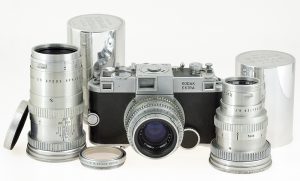
In 1941, Kodak would release the Kodak Ektra which was their one and only attempt at a high end interchangeable lens rangefinder camera that could compete with high end models like the Ikon Zeiss Contax and the Leitz Leica. The Ektra sold extremely poorly because of its very complicated design and extremely high price. In 1948, a Kodak Ektra sold for $700 which was outrageous for the time. Adjusted for inflation, $700 in 1948 is equal to $6922 in 2015!
For most people in the 1940s through the 1960s, if you owned a Kodak camera, it was most likely a very basic model like one of the many Kodak Brownie, Tourist, or Pony models.
Despite being the premiere maker of 35mm film, Kodak would exit the camera making business altogether in the late 1960s and not return until the mid 1980s and even then, Kodak would make little effort to cater to high end professional photographers.
It’s this intermittent and puzzling history that confuses, yet intrigues me about how the company was run. As a collector, its very easy to dismiss anything with a Kodak name on it that’s not a Retina.
If you dig a little deeper and look at some of the other models that were produced, you will find that there are a couple of really interesting ones. This review is about the Kodak 35 which was a model produced for just over a decade, from 1938 to 1951 (the non-RF model was discontinued after 1948).
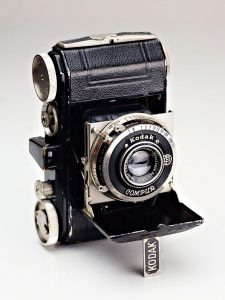
I mentioned at the very top of this article that both of the cameras pictured here are called the Kodak 35 and are basically the same model. Although Kodak already had the Retina from 1934 which could use their new 135 format 35mm film, it was a German design that carried a hefty price tag. The early Retinas sold for anywhere between $100 – $150 which adjusted for inflation is well over $1200 in 2015 dollars.
Upon the release of the Retina, Kodak would have almost immediate competition from other German makers such as Leitz, Zeiss-Ikon, Certo, Welta, and many other Dresden companies. Back in the United States, American companies like Argus would start making inexpensive models that could also use this new film, but sold for much cheaper than their German competitors.
In 1936, Argus would release the Argus Model A which was a basic Bakelite bodied camera with a stamped tin back and a collapsible lens with a 4 speed shutter. The Argus A sold for $12.50 in 1936 which is roughly $214 today. Considering photography was still a niche industry, this would be one of the first models that were within the price range of the average middle class American family.
The Argus A-series was an immediate success and would precede the Argus C-series which debuted 2 years later which featured an integrated rangefinder, a better lens that was interchangeable, and a wider range of shutter speeds.
I do not know if Kodak already had plans to release an American made model targeted at the budget consumer prior to the Argus A, or if the creation of the Kodak 35 was in reaction to, but whichever the case, in 1938 Kodak would release their new model, made entirely in the United States to compete with Argus.
The Kodak 35 had a heftier design and has better ergonomics of either the Argus A or C-series cameras. It also featured slightly better lenses and double exposure protection (which both Argus cameras lacked). Although not interchangeable like on the C-series, the Kodak 35 had an optional Anastigmat Special (later renamed the Anastar) 4-element lens with a maximum aperture of f/3.5 that performed quite well.
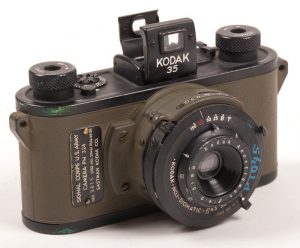
The Kodak 35 also was used by the US military during World War II. There were some olive green models made by Kodak for specific use by the US Army.
Edit: After posting this review, I was given some excellent information about these military issue Kodak 35s from Vintage Camera Collector, Rick van Nooij. Rather than paraphrase, I’ll just copy and paste everything he said:
For the US Army they were part of the military Photographic Set PH-261, which was mainly used for developing, printing and copying documents for S2 in the field.
I’ve seen exactly two photographs of these cameras being used outside of the set during the war.
Top and bottom trim on these are made out of brass on most of the ones I’ve seen, though I’ve seen a few aluminium ones, which might be fakes or late-war brass-saving versions.
The bodies are the same black plastic but sprayed green. You find them marked with orange Signal Corps acceptance stamps or simply stamped “PH-324” in black ink.
Lenses on these are always the 51mm f/4.5 Kodak Anastigmat in a No.1 Diomatic shutter.
There was also a USN variant with a periscope attachment.
Despite these improvements to Argus’ designs, the Kodak 35 did not sell well, which was most likely due to it’s price. In 1938, the Kodak 35 sold for $40, which was still considerably cheaper than the Retina, but it was more than double that of the Argus A-series and higher than the $25 price point of the Argus C-series.
Edit: I’ve read many pages including Kodak’s own list of cameras saying that the Kodak 35 originally sold for $40, however there is a lot of evidence that the street price was much less. Popular Photography ran a couple of ads in 1939 that shows that the Kodak 35 was available for the following prices:
- Kodak 35 Anastigmat f/5.6 lens and Kodex shutter – $14.50
- Kodak 35 Anastigmat f/4.5 lens and Diomatic shutter – $24.50
- Kodak 35 Anastigmat Special f/3.5 lens and Kodamatic shutter – $33.50
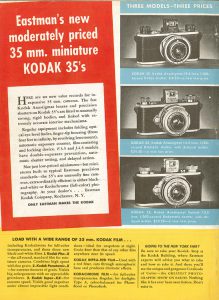
I’ve seen at least a couple of other ads from this period with the same prices, so perhaps $40 was the MSRP of the Kodak 35, but the actual prices were significantly less. If so, then all but the top of the line model would have been less expensive than an Argus C3 despite its reputation as being quite a bit more expensive.
By 1940, Kodak realized their mistake by offering a scale focus only, yet more expensive model compared to the Argus C3, so they quickly adapted the Kodak 35 to address it’s most significant shortcoming, which was the lack of a rangefinder. This new model would officially retain the name Kodak 35, but would unofficially be known as the Kodak 35 Rangefinder or RF for short. The rangefinder model would sell for $48 in 1940, almost double that of the Argus C3.
Rather than redesign the camera from the ground up, Kodak simply designed a new top plate and external linkage that would sit outside of the body which would add a rangefinder to the model. These external parts are the bulbous and strange looking pieces on top and to the side of the lens on the later model.
Despite it’s strange appearance, the new design actually worked quite well. When paired with the excellent Anastigmat Special lens, the Kodak 35 was a very capable camera.
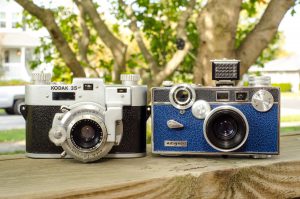
I have not seen any sales numbers of the Kodak 35 series, but they would have been nowhere near that of the Argus C-series which stayed in production until 1966, selling nearly 2 million copies.
Despite being thwomped in sales and having a production run less than half as long as the competition, I would hesitate to call the Kodak 35 a failure. The Kodak 35 RF somehow looks better in person than it shows in pictures. It’s a cool looking camera that certainly draws attention to itself. While I absolutely hate the term “steampunk”, it definitely falls into that niche, and like I said earlier, it is a nicely built camera that can produce excellent results.
Today, the Kodak 35 is not the first, second, or even third model that would pop into someone’s mind when they think of a mid century Kodak camera. Other than the Retina and maybe the Medalist, many collectors stay away from anything with Kodak’s name on it. This fact means that most of these models sell for very cheap. They are plentiful on eBay and you can easily pick one up for $25 or less.
They were well built and are pretty easy to work on, so even if you get one that’s not in working condition, most likely all it needs is a good cleaning and you should be able to restore it in good working order.
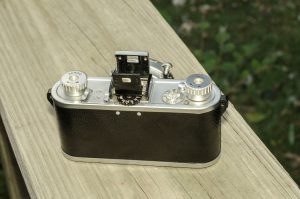
My Thoughts
I have realized recently that I have more of an interest in Kodak cameras than I ever thought I would. There have been so many well designed and desirable models made in Germany and Japan, that its hard to remember that America made some too. Sure, we all know Kodak for their early box and folding cameras, and then in the later years they had quite a few Instamatics, and of course there’s the (German built) Retinas which were pretty good, but the models that fall in between don’t often get mentioned on people’s top list of collector cameras.
The thing about both Kodak 35 models is that pictures do not do them justice. You can look at a picture of a Pentax Sv or an Ihagee Exakta and immediately see their beauty. People know that Leicas and M39 screw mount Canon rangefinders were great, but the Kodak 35s don’t have a luxurious reputation. Their shutters are kinda basic, and in the case of the RF model, they’re pretty weird looking.
When you hold one in your hand, you really start to appreciate their beauty. The original Kodak 35 has a spartan simplicity that’s beautiful. The Bakelite body doesn’t feel cheap like a mid 50s Brownie box camera or Argus Seventy-Five. They’re very solid, in the same way that the Argus C3 is a very solid camera. Even the RF somehow looks better in person than any picture could show you.
The folding viewfinder on top of the Kodak 35 is large and bright (for the era). A typical 1930s viewfinder camera would have a minuscule viewfinder that you had to squint to look through. Forget about seeing the whole frame if you wear prescription glasses. The viewfinder on the Kodak 35 is incredibly basic, its just two spring loaded pieces of metal with glass lenses in them. Yet, when you look through it, if you move the rear piece of the viewfinder forward or backward, it functions like an adjustable diopter. Yeah, thats right, this camera has a diopter that has quite a bit of range of motion. There is a little dial beneath the viewfinder that raises or lowers the entire viewfinder to adjust for parallax, based on the distance you set it to. Its not coupled to anything, so you have to remember to change it manually, but still, parallax correction, and an adjustable diopter on a large and bright viewfinder in a camera from the 1930s? Come on! How many other cameras from this era has that same combination of features?
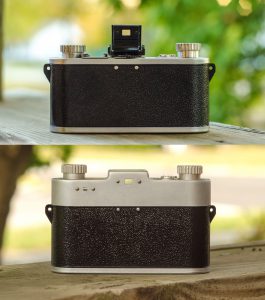
The RF model’s haphazard implementation suffers a bit in this regard – the viewfinder is small and has no diopter or parallax correction. It functions very similarly to the Argus C3 in that you look through the smaller window on the left for the split image rangefinder, and then you have to move your eye to the small main window to compose your image. I wouldn’t necessarily say this is a bad thing, since the RF model is more in line with other cameras from the era, but if you can live without a rangefinder, the original Kodak 35 is by far the easier of the two to compose an image with.
Throughout the production run of the entire Kodak 35 series, there were some variations of lens and shutter combinations, along with some cosmetic changes.
You can easily date most Kodak 35 models via the serial number on the lens. Starting in 1940, Kodak started using a CAMEROSITY code which had a two letter prefix to the serial number which indicated the year the lens was made. Simply take the word “CAMEROSITY” and link each letter to the numbers like this:
| C | A | M | E | R | O | S | I | T | Y |
| 1 | 2 | 3 | 4 | 5 | 6 | 7 | 8 | 9 | 0 |
Using this CAMEROSITY code, if the first two letters of the serial number are EI, you know that it was made in 1948. If the serial number is all numeric with no letters, then it was made pre-1940.
It’s worth noting that Kodak had a UK division that did the same thing, except they used the word “CUMBERLAND” to mean the same thing.
The earliest pre-war models had black anodized knobs and in the case of the RF model, I have seen one with a black rangefinder cover. These black variants are not common as most of them look like the two I have. A more common variant are in post war models from around 1947 in which the knobs were changed to a white plastic that has a tendency to yellow over time. If you see a Kodak 35 with yellowish looking plastic knobs, you know it is a later model. I much more prefer the all metal knobs like both of mine have.
Before the war, Kodak 35s came with one of two lens/shutter combinations:
- A base 50mm Anastigmat f/5.6 lens with Kodex 3 speed Shutter and black knobs
- An uplevel 50mm Anastigmat Special f/3.5 lens and 5 speed Kodamatic Shutter and silver knobs
After the war, the base f/5.6 model was dropped and flash synchronization was added to all models. A special Luminzed coating was also applied to all of the available lenses. The available models were:
- A base 51mm Anastigmat f/4.5 lens with 4 speed Flash Diomatic shutter
- An uplevel 50mm Anastigmat special f/3.5 lens and 5 speed Flash Kodamatic shutter
In the late 1940s (my best guess is around 1948), Kodak re-branded their Anastigmat and Anastigmat Special lenses under the names Anaston for the base lens, and Anastar for the uplevel lens, but the lens design was unchanged.
The Kodak 35 RF model was only available with the 50mm Anastigmat Special / Anastar f/3.5 lenses. Wikipedia incorrectly lists a 51mm lens being available, but no Google image search returns any Kodak 35 RFs with a 51mm lens.
There is conflicting information about when production of the Kodak 35 and the RF model was discontinued. Some sites refer to an earlier edition of McKeown’s Collectors Guide that says 1948, but I have personally seen a Kodak 35 RF with a serial number dating it from 1949, and Kodak has a chart on their site saying the original model ended production in 1948 and the RF model in 1951. When the Kodak 35 RF was discontinued in 1951, it was replaced by the Kodak Signet 35 which was a much smaller 35mm camera with an excellent rangefinder and an overall much nicer design.
Repairs
I acquired both my Kodak 35 and RF models around the same time and both of them had the same issue in that they were both very stiff.
A stiff focus is to be expected on any old camera as whatever type of lube or oil was originally used ends up drying out and turning into a sticky, sludge-like substance over the course of several decades. Normally however, if you can deal with the stiff focus, these cameras are usually still usable. They just require slightly more effort to turn the focus wheel.
The Kodak 35s both have a self-cocking mechanism in which advancing the film also cocks the shutter. This is done via the sprockets on the actual film which turns a shaft that is coupled to a sliding lever which pushes a cocking pin on top of the shutter. You can actually see this pin move on both Kodak 35 models because it is painted red to indicate that the shutter is cocked. After the shutter is fired, the red part moves out of position and you can no longer see it. Cock the shutter again and the red part comes back.
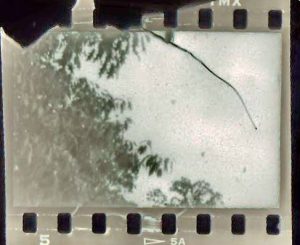
The problem is that when this part of the camera becomes stiff, it requires extra effort for everything to move and that can tear or damage the film when trying to advance it. If the sliding lever on the shutter is stiff, the pin is harder to move, and therefore that sprocketed shaft inside of the film compartment is also hard to move. If you try to advance the film when all of this is stiff, you’ll end up tearing your film. The image to the left is from a Kodak 35 camera that tore the film because everything was stiff.
Thankfully, both the RF and non-RF models are mostly repaired the same way. The only real difference is that in the RF model, you have to remove the top plate, coupled gears, and gear covers. This might sound intimidating, but if you take your time and keep track of all of the screws and parts, its not hard at all.
Dan Mitchell has an excellent walk through on how to disassemble a Kodak 35 RF. A word of caution is when removing the top plate, you do have to remove the screw that goes through the wind knob, but so not remove the wind knob itself. There are 3 spring loaded bearings in there that are a huge pain to put back together. The cover will come off with the wind knob still attached, just leave it alone!
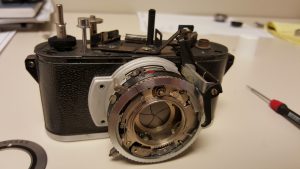
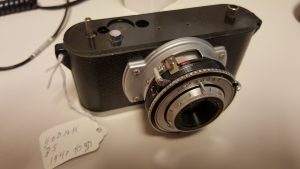
His tutorial goes a little farther into the camera than is necessary. Once you have the top plate and the coupling gears off, you do not need to remove the actual mirrors or any of the arms connected to the mirrors. Just leave them be and clean them with some rubbing alcohol soaked Q-tips.
When disassembling the lens elements, be sure to pay attention to the orientation of the front lens element and count how many turns of it are required to unscrew it. You will need to reinstall it in the exact same orientation and with the same number of turns otherwise your focus is off. If you don’t get this right, you will need to collimate the lens. This isn’t hard to do, and I have an article that shows you how to do this, but it’s just extra effort that can be avoided by going slow and paying attention.
Once you have the outer lens lens element off, you are faced with the inner lens element that has no notches or any type of grip to unscrew it. You cannot use a lens spanner or screwdriver to get this out, and although Dan Mitchell suggests being able to use a friction tool, I was unable to do this on either of my Kodak 35s. I chose the scarier method of drilling two small holes opposite of one another in the brass ring and then using my spanner tool to remove it.

If you choose to drill holes, use the smallest drill bit you have. The size drill bit I used was unecessarily large, but it didn’t cause any problems. This ring is made out of brass, which is very easy to drill into, so it requires very little effort for your drill bit to bite into the metal. Go very slow and let the drill go into the metal until you feel it break through to the other side. There is nothing sensitive immediately behind this brass ring, so once it breaks through, as long as you are not using too much force with the drill, there is nothing to damage. I said this already, but its worth repeating, go SLOW!
This inner ring is also what controls the focus. The threads on this inner ring will have some old lubrication on them. Using many Q-tips and lighter fluid, clean them thoroughly. Once you have cleaned off all the old lube, put the whole inner ring in a safe location for later.
There will be brass shavings from your drilling in the shutter. Make sure you clean these out thoroughly. Since you will be cleaning the entire shutter, these will pretty much be cleaned out anyway, but its always important to be sure.
Flush out the entire shutter using lighter fluid like you would on any other shutter. Since there are no bellows in either of these cameras, it is OK to be generous in your lighter fluid. It will get on the inside of the inner lens, but that is easy enough to clean when you’re done. If the shutter blades were sticky or covered in oil when you acquired your camera, this will also clean that. You’ll need to do this many times and let it dry for several hours in between each application of lighter fluid.
Once you are sure your previous cleaning is totally dry, try firing the shutter a couple of times and see if it sticks or binds. If so, repeat the process until it stops sticking. If there are some remnants of brass shavings from your drilling, you can use some compressed air, but you MUST be gentle! Do not use the full force of the compressed air as it can damage the shutter blades. Hold the can a couple of inches away and only pull the trigger part of the way. You can do even more damage if you apply too much force to the shutter blades.

Once the shutter and everything is clean and working properly, reassemble the camera in the opposite of how you took it apart. Assuming you remember the correct orientation of the front lens element and how many turns it took to remove it, you shouldn’t have to adjust the focus, but its something I would probably do anyway. Remember these cameras are anywhere from 64 to 77 years old and there is a very good possibility that something could have happened along that way, or some previous owner may have attempted his or her own repair, so checking focus is something I recommend on any camera.
The RF model specifically has a couple of extra steps to assure that the gears are correct. Make sure that when the lens is at infinity, the focus ring is correctly pointing to the 3 o’clock position where the little mark is on the gear cover. I had actually forgotten about this when reassembling my RF and had infinity at the 12 o’clock position which is incorrect.
My Results
After getting both of my 35s in good working order, I decided to try out the non-RF model first. Even though it lacks a rangefinder, I think it is a better looking camera, plus I will always prefer a larger and brighter viewfinder over a tiny little hole that you have to squint to see through.
I’ll say this right now, what a wonderful camera the Kodak 35 is. If you were to ask me to predict my thoughts before actually shooting with this camera, I would have assumed that it would be like many of the older cameras I own. It would be fun to use for one roll, but then afterwards, it would probably sit on the shelf for an undetermined amount of time while I cycle through other cameras in my collection.
Not so.
I really enjoyed my time with the Kodak 35, and I definitely see taking this camera out again in the future. As poorly thought out as Kodak’s decision was to use the actual film to move the sprocket that cocks the shutter, when it is working, it works well. The sound of the shutter being cocked makes a very satisfying ker-chunk noise. Maybe one day I’ll get a recording of it and post it here. This is one reason why I think a CLA on this camera is so important. The film itself plays such an important role in the operation of the camera, you want it to be as clean and smooth as possible.
I’ve already talked about the viewfinder, but its worth repeating that the viewfinder on this camera is very basic, but really well designed. It is large and easy to look through, it folds out of the way when not in use, and when folded down, the front piece has a natural curve to it which makes it relatively easy to slide in and out of your pocket. I didn’t do many closeup shots with the camera, so the adjustable parallax knob wasn’t of much use, but I appreciate it being there.
The rounded edges of the Kodak 35 feel better in your hand, and definitely make walking around with this camera much more pleasant than say, the Argus C3 which would have been this camera’s primary competitor.
My first roll was shot on AGFAPhoto Vista 200, which I think is a perfect match for the shutter on the Kodak. I shot every single one of these using Sunny 16, and for the horse racing pictures, I just shot wide open with a 1/50 shutter speed and things came out nearly perfectly exposed. I’d say the shutter speeds on this old camera are probably spot on.
The 4-element Anastigmat Special lens is no joke. This is an uncoated lens, but frankly, I cannot see how the post-war lenses with the Lumenized coating could be any better. I am very happy with the color and contrast of the shots I got.
The Kodak 35 certainly isn’t the “best” or most capable camera in my collection, but it is the one that surprised me the most. I can’t think of another time I shot with a model that I had low to modest expectations which were blown away by the time I had finished the first roll. As nice as they are, it’s not all about the quality of the images. Shooting with this camera is a joy. I’ve said it several times, but the viewfinder is so easy to use. This is probably the easiest scale focus camera I own, and a huge part of that is the bright and easy to use viewfinder. Considering its very easy to clean and theres no mirrors or prisms to get dirty, this is a camera thats just as easy to use as the day it was made, 76 years later. Just let that sink in for a moment…76 years!
There have been many instances in history where two products went head to head, and the one that sold the best was not always the better product. BetaMax vs VHS, Sega Master System vs Nintendo Entertainment System, and everything else vs the iPod are all examples where the technologically superior product lost out to some other technology or system. While the Argus C3 is a great camera for many reasons, I really think the two Kodak 35s were a better designed camera, with better ergonomics, and better optics. If Kodak would have done a better job of integrating the rangefinder into this camera, I think its sales would have definitely been better than they had.
| My Final Word Kodak 35 non-RF |
The Kodak 35 is not unlike other cameras of the late 1930s, but this is definitely a case where the camera adds up to more than just the sum of it’s parts. This is a well built camera with a great lens and shutter, thats easy to use, and has a great viewfinder. Almost every shot from my very first roll came out very nice. The Kodak 4-element Special lens is a gem. The pictures it makes are rendered beautifully with excellent contrast and sharpness. I would strongly recommend that anyone who acquires one of these to clean it before using it, it is a very simple camera to clean and maintain. This camera isn’t the best, or most capable in my collection, but it’s the one that surprised me the most after shooting a roll. I will definitely shoot with this camera again. | ||||||
| Images | Handling | Features | Viewfinder | Feel & Beauty | History | Age | |
| 1 | 1 | 0 | 2 | 2 | 1 | 40% | |
| Bonus | none | ||||||
| Final Score | 9.8 | ||||||
Additional Resources
https://en.wikipedia.org/wiki/Kodak_35
http://camerapedia.wikia.com/wiki/Kodak_35
http://www.web4homes.com/cameras/kodak-mid.htm
http://www.tcp-ip.or.jp/~peachan/camera/kodak35/index-e.html
http://www.mconnealy.com/vintagecameras/kodak35/index.html
http://pheugo.com/cameras/index.php?page=kodak35
http://mattsclassiccameras.com/kodak_35rf.html
http://www.photoethnography.com/ClassicCameras/Kodak35RF.html
http://blog.jimgrey.net/2015/03/30/kodak-35/
https://sites.google.com/site/contraptionsinphoto/kodak-35-rangefinder
http://camera-wiki.org/wiki/Kodak_35_RF
https://www.flickr.com/photos/steevithak/sets/72157626331809837/

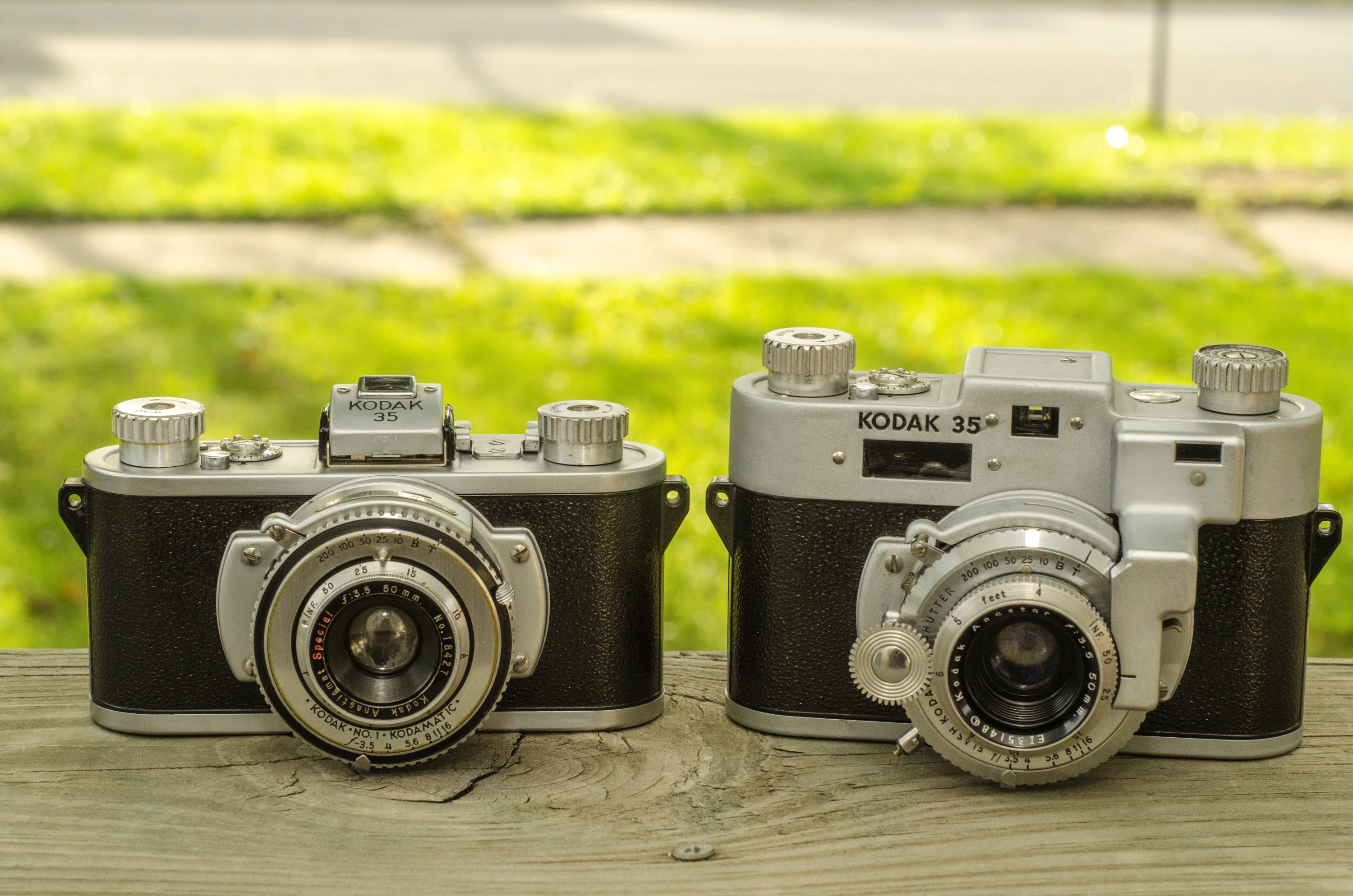
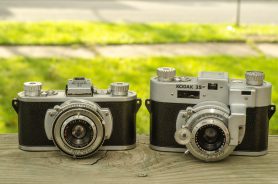
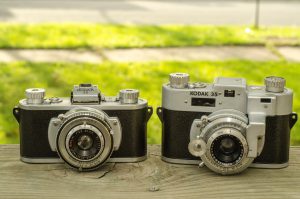












Hello I have a question please if you can reply here or by e-mail. I have this Kodak 35 RF but the knobs are black. I haven’t seen any other one like this. Does this mean somebody has already opened it up and replaced the knobs, say, with the black ones from a similar olive drab camera.
Hi Armando, having black knobs on the rangefinder Kodak 35 is not unusual. Many of them produced during and right after the war had black knobs. Some even had a black painted cover on the front of the camera covering the gears. What is the serial number on your lens? That’ll tell you when the camera was made.
Serial is ER21646
I appreciate the quick response.
Some pictures of the weird black trims on my Kodak 35. I’m not sure but I don’t think this is stock, is it?
https://i.postimg.cc/T39Bghg1/IMG_20181003_135750.jpg
https://i.postimg.cc/YqX1FHjk/IMG_20181003_135827.jpg
I’ve been looking around, trying to figure out what kind of flash I can use. Any tips/leads?
Hi Mike, another very detailed and useful review. I recently picked up an early 35 (pre-1940 judging by the s/n) I agree with you that they have a charm of simplicity and are better in person than in photos. Unfortunately mine is currently non-functioning – the focus is seized and shutter cocking/firing is intermittent. I’d love to shoot this one day but for now it decorates my office desk.
I have a 1941 Kodak 35 that I really enjoy using. The lens is excellent, and the peculiar handling is charming rather than limiting. Mine is in almost like-new condition, and works perfectly. It doesn’t have that cool parallax correction knob though—perhaps that was optional? SN EC4513, 50 3.5 “Special”
I’ll be perfectly honest, the Anastigmat Special version I have is the only one of these I’ve ever owned, so I’m not sure if the lower end versions lacked that parallax feature, but you could be right. To be perfectly honest though, it’s not all that useful. The few times I tried to shoot that camera at minimum focus, I never remembered to use it!
Is there any significance to having a 1945 Kodak 35 Rangefinder with 4 digit SN rather than 5 digits?
Not particularly. All I can tell you is not many were made in 1945 as the war was coming to an end, so having a ’45 model is a bit uncommon.
Hi there! I just did my first camera repair on a Kodak 35 rf. Everything went swimmingly…aside from misreading instructions for removing the winding knob. I did it. I did the thing that you don’t do. The springs and bearings came out. I’ve been scouring the internet to find how they go in, but have found nothing. I miraculously collected all of the teeny tiny springs and bearings, but can’t for the life of me figure out how they should be positioned.
Do you have any guidance? It was my great grandfather’s camera so I’m determined to find an answer.
I’m sorry to hear that Kristin! I’ve personally never taken that knob apart, so I can’t offer you any suggestions on how to get it back together, other than to perhaps suggest looking for another camera online and using that one as a practice camera to see if you can figure it out on a camera that wasn’t your grandfather’s. If you can get it working on a practice camera, maybe you can figure it out on the other one. Good luck!
Hello Mike,
I just got the non-rangefinder and all is well except the sprocket shaft is stiff, which seems to be common. I don’t see anything about fixing it in your post above or the linked one. I hope you can help.
The sprocket shaft is stiff because it’s coupled to the shutter. you’ll need to clean the shutter and get it moving smoothly and that will un-stiffen the sprocket. I still like that camera, but that design where cocking the shutter is part of the film transport was a bad idea from Kodak.